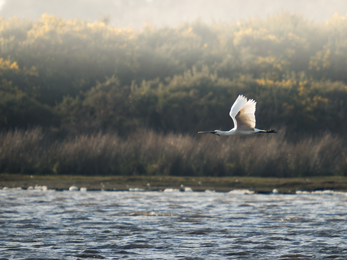Almost as tall as a grey heron, the spoonbill feeds on shrimp and aquatic invertebrates. It likes to feed in flocks, swinging its slightly open beak from side to side through shallow pools of water. Its remarkable spatula-like bill is packed full of sensors attuned to the tiniest vibrations, and once located, unlucky beetles, crustaceans, worms, small fish, tadpoles and frogs stand no chance of escape.
The British Trust for Ornithology believes that 10 years ago there were only about 100 spoonbills in the whole country, with even fewer opting to nest here. While spoonbill populations have historically declined in the UK due to habitat loss and human disturbance, greater protection to breeding sites, warmer weather and more feeding opportunities are leading to its slow but steady recovery.
At this time of year, overwintering populations start moving towards traditional breeding grounds in the Netherlands and northern Europe, but a small, growing number of spoonbills have begun establishing breeding colonies in the UK, primarily within coastal marshes and estuaries, most notably in Norfolk. The new sightings on the southern edge of the New Forest, highlight the importance of conserving these crucial environments to provide more space for this wonderful species to feed and rest, as well as increase the potential for it to expand its breeding range.


